Best CBD for Pain Relief
CBD has been a popular topic in recent years but many still may have questions about the substance: What is CBD? What is CBD used for? How can CBD manage pain? What are the best CBD products for pain relief?
Luckily, we are here to answer all your questions related to the extremely useful and often mischaracterized chemical that is CBD. CBD has increasingly become an accepted treatment for pains and aches related to a number of medical conditions: normal injuries, fibromyalgia, sciatica, and more. It has also seen use as a treatment for neurological conditions like epilepsy.
Despite the growing acceptance of CBD as a viable medical treatment, there are still many unsubstantiated rumors about CBD and what it can do. We are here to dispel those rumors and give a clear and scientific account of CBD and the benefits of using CBD for pain management. Additionally we will help to identify the best CBD for pain relief.
First, let’s tackle the simple question: what is CBD? Then we will move on the the specific questions of pain and how CBD can be used to manage pain.
What Is CBD?
CBD (cannabidiol) is a naturally occurring chemical that is found in cannabis plants. CBD is one of 113 identified chemicals that are found in marijuana and composes about 40% of the plant’s extract.
CBD is a cannabinoid; a type of chemical that reacts with cannabinoid receptors in the brain. At room temperature, a pure sample of CBD is a crystalline solid. It is insoluble in water but soluble in organic substances such as ethanol or pentane. There are over 100 different unique isomers of cannabidiol that are found in the oily residue of cannabis plants. CBD and other cannabinoids are produced in the trichomes of cannabis plants; the small hair-like appendages that cover the main body of the plant’s flower.
It is important to realize that CBD is not the same thing as THC (tetrahydrocannabinol). THC is a different kind of cannabinoid that is characterized by its psychoactive effects when ingested (being “stoned”). THC is classified as a schedule I narcotic and its sale and consumption is illegal or regulated in many countries and states. CBD, in contrast, has little to no psychoactive effects because it interacts with different receptors than THC. CBD is generally not classified as a controlled substance and its sale and use are generally not restricted, though the exact rules surrounding its sale and use differ from state to state.
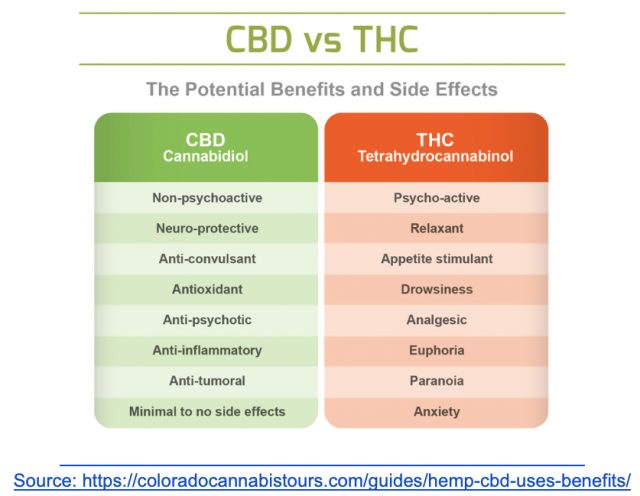
Source: https://coloradocannabistours.com/guides/hemp-cbd-uses-benefits/
Pain: What Is It?
Before seeing how CBD can be used to manage pain, we need to figure out exactly how pain works in the body.
To be completely honest, pain is an extremely tricky subject to nail down. The International Association for the Study of Pain defines “pain” as “an unpleasant sensory or emotional experience associated with actual or potential tissue damage, or described in terms of such damage.”[1] This is a broad and somewhat subjective definition, so the concept of pain is normally broken down into categories based on the underlying physical mechanisms associated with the experience of pain.
For our purposes, the two most relevant kinds of pain are nociceptive pain and neuropathic pain.
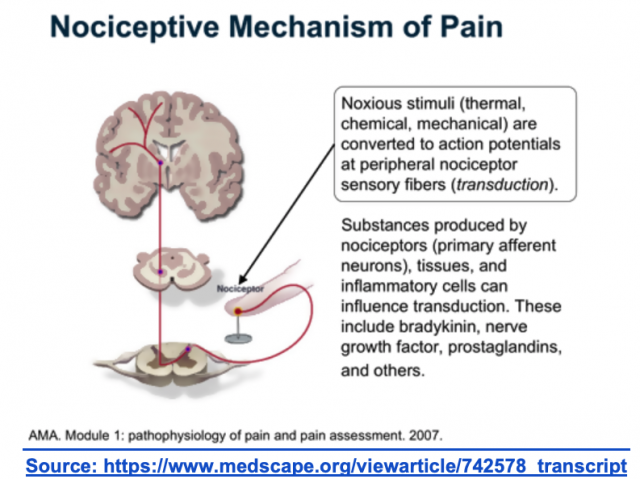
Nociceptive pain
Source: https://www.medscape.org/viewarticle/742578_transcript
This is the most common kind of pain and occurs when sensory nerves are activated by harmful or potentially harmful stimuli. These stimuli could be chemical (acid burn), mechanical (trauma), or thermal (heat and cold). Exposure to these kinds of harmful stimuli activates sensory nerves called nociceptors which send a signal along the peripheral nervous system to the spinal cord which relays the message to the pain centers of the brain.
Nociceptive pain is most commonly associated with swelling of the affected area. Inflammation is caused by the body’s white blood cells releasing healing factors meant to protect vulnerable regions of the body, like an open wound after you are cut. These beneficial chemical have the negative side effect that they leak into other areas of the body causing swelling and redness. The pressure of these fluids can press on nociceptors, causing more pain.
Neuropathic pain
Neuropathic pain is caused by damage to the nerves, which is why it is sometimes called “nerve pain.” Essentially, neuropathic pain is the result of damaged neural tissue sending bogus signals to the brain in the absence of any mechanical, chemical, or thermal stimuli. Neuropathic pain is often describing as a burning tingling or shooting sensation radiating from the affected area. Neuropathic pain is associated with many conditions that result in the degradation of neural tissue, such as AIDS, diabetes, phantom limb syndrome, multiple sclerosis, and fibromyalgia.
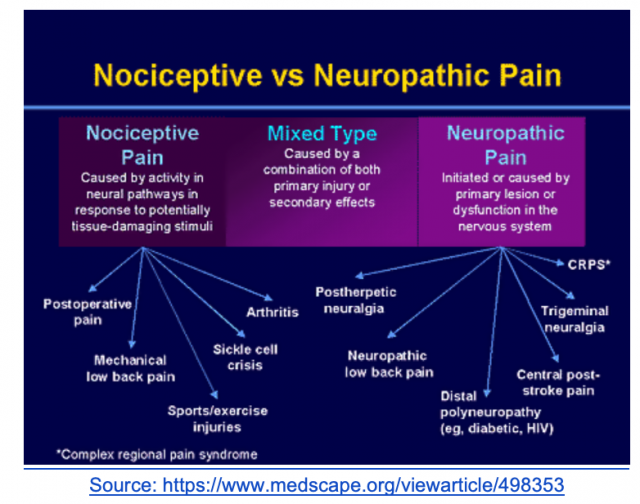
How Does CBD Manage Pain?
While an explicit description of the molecular specifics behinds CBD’s mechanism of action is not completely understood, scientists have a few hints about how CBD reduces and manages pain in the human body. Even better, CBD does not seem to be addictive and does not create a physiological dependency. The two main ways that CBD manages pain are by its interaction with the immune system and by blocking receptors in nerves that communicate pain signals to the brain. Let’s take a look at each of these effects.
CBD as an anti-inflammatory
Recall that one of the effects associated with nociceptive pain is swelling and inflammation in the affected sites. This swelling can cause further pain by pressing on nociceptors. This swelling is caused by lymphocytes which are released by T-cells in the immune system. There is a growing body of evidence that CBD reduces inflammation by interacting with the immune system and slowing the production of lymphocytes by T-cells[2]. The result is a reduction in swelling of the affected areas. Specifically, it is believed that CBD regulates the immune system by acting on CB1 and CB2 receptors in immune cells.
Suppressing the immune system is not always a good thing. This is because inflammation usually serves a purpose in fighting infection and damage. Inflammation serves to isolate harmful pathogens, increases blood flow to damaged tissue, and lets the body know that something is wrong.
With some autoimmune disorders, an overactive immune system is the main culprit. Autoimmune disorders like rheumatoid arthritis, multiple sclerosis are characterized by the immune system attacking healthy cells which causes perpetual inflammation and pain. Preclinical evidence suggests that CBD can be very effective at slowing down an overactive immune system which is the root of the pain associated with many autoimmune disorders[3].
CBD as a receptor antagonist
Following a nerve injury, receptors in damaged tissue may become more sensitive to stimuli. Oversensitive receptors are thought to be the main culprit in cases of neuropathic pain. It has been discovered that CBD slows the rate of nociceptive conduction in the spinal cord by binding to CB1 receptors in nervous tissue[4]. Blocking these receptors interferes with the bogus pain signals being sent from damaged nerves, which results in less neuropathic pain.
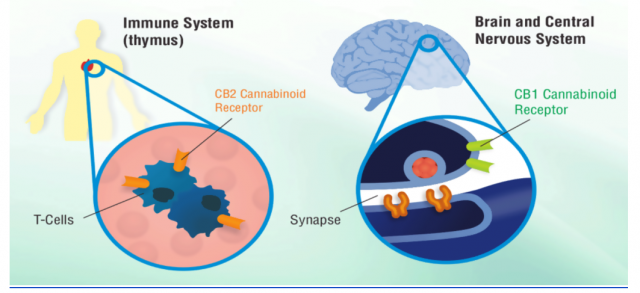
Source: https://www.alpha-cat.org/introduction-to-cannabinoids/
The scientific study of CBD for pain management is still in its infancy. As such, CBD is NOT approved by the FDA for pain management (interestingly, CBD IS approved for the treatment of 2 very rare forms of epilepsy). However, a growing body of anecdotal evidence drawn from users personal experiences seems to indicate that CBD usage is a very effective and safe way to manage pain. Several users on message boards for those who suffer from things like multiple sclerosis and fibromyalgia claim that CBD has been much more effective at managing pain than traditional methods of pain management.
To be very clear, anecdotal stories are NOT scientific data, yet in the absence of properly funded clinical trials, they are at least a good indication of the potential for the substance in treating pain disorders.
The lack of rigorous trials to determine the efficacy of CBD also means that it is not understood how CBD may react with other common medications and drugs. Make sure to consult your physician before trying CBD to identify any possible risks.
How Is CBD Ingested?
CBD can be ingested in a variety of ways. The immediacy and degree of effects of CBD are partially dependent on the method of ingestion.
CBD oil
CBD oil is probably the most common method of CBD ingestion. CBD from the cannabis plant is extracted and mixed into a liquid solution that can be administered via an eye dropper. CBD oil can be directly ingested by placing some of the solution in the mouth or can be added to food while cooking. CBD oil is typically fast acting (5-15 minutes) but some do not consider it discreet enough or dislike the taste of the oil.
CBD capsules
CBD can also be refined into a gel, where it can be administered by the mouth in the form of pills. CBD capsules are essentially the same thing as CBD oil, just in a convenient pill form. CBD capsules are great for taking regular controlled doses and circumventing the potentially offputting taste of CBD oil.
CBD lotions
CBD is also made into lotions and topical creams that can be directly applied to painful areas of the body. CBD gets absorbed through the skin. CBD lotions are great for treating localized immediate pain from things like arthritis, sprains, and muscle injuries.
CBD crystals
CBD can also be refined into its pure crystalline form. CBD crystals are very high concentration and can be directly eaten, dissolved in food, sprinkled onto a cigarette, or directly vaporized and smoked. Because the refining process takes more time and resources, CBD crystals are normally more expensive than liquid and gel solutions.
CBD vaping
CBD can also be vaporized and directly inhaled. Vaping involves heating CBD to a certain temperature until it transforms into a vapor which can be inhaled. Vaping is not the same as smoking becaue vaping usually involves no combustion, so it does not produce carbon dioxide or carbon monoxide. Vaped CBD is normally very highly concentrated so it is not recommended for beginners who have no previous experience taking CBD.
A word on vaping CBD; while it is normally considered safer than smoking, it is not clear that vaping has no negative effects. It is believed that vaping CBD might not break down the waxy materials from the plant’s leaves which may build up in the lungs over long-term use. Unfortunately, there is no clear scientific consensus on the issue as of now. The dangers are further compounded as there currently do not exist any strict quality regulations on the manufacture of CBD vaping mixtures. If you wish to try vaping CBD, make sure to consult your doctor first.
CBD VS Medical Marijuana
The use of both CBD and marijuana to treat pain is on the rise. In fact, many states that have legalized medical marijuana for pain management have seen a decline in addiction and the use of opioids and other common pain medications[5].
Despite the increasing prevalence and acceptance of medical marijuana as a treatment, CBD shows some advantages over medical marijuana, such as:
- CBD is generally not illegal and is not a controlled substance like medical marijuana.
- Medical marijuana is normally consumed by smoking and vaping, which can hurt the lungs. CBD can be directly eaten or used as a topical cream.
- CBD produces minimal psychoactive effects and is not associated with the feeling of being “high” or “stoned.”
- Large quantities of medical marijuana can increase paranoia and anxiety; CBD use, in contrast, has not been shown to increase paranoia or anxiety.
- Medical marijuana can produce a “hangover” effect which involves decreased concentration and slowed reaction times. CBD does not.
- CBD is an alternative to medical marijuana for those who do not want to be associated with the history or culture surrounding marijuana.
- CBD does not produce the “skunk” smell of marijuana.
- CBD does not require a prescription.
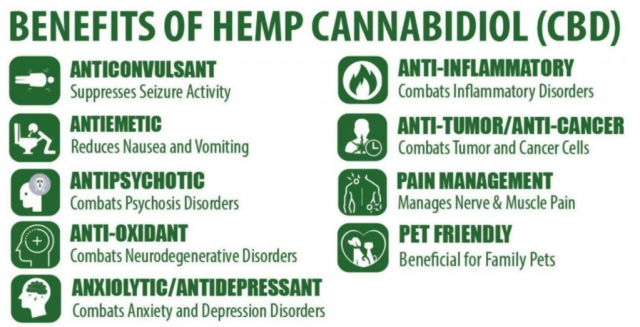
Source: https://learnsativa.org/cbd-oil-benefits/
What Are the Best CBD Products for Pain Management?
Now that we have all the technical stuff out of the way, let’s take a look at some of the best CBD brands and products for managing pain.
Founded in 2014, NuLeaf Naturals is one of the best known CBD companies and are known for their high-quality CBD oils and extracts. All their products are derived entirely from the natural cannabis plant and feature no synthetic chemicals or additives. Their CBD products offer a range of concentrations meant for dealing with mild to moderate pain. Their CBD oil products are also useful for helping insomnia and mild to moderate depression and anxiety.
PlusCBD Oil is one of the first companies in the US to begin offering CBD products for pain management and probably occupy the most retail space for CBD products. Their signature “gold formula” is a mixture that contains CBD, fatty acids, vitamin E, and terpenes. Their gold formula is offered in 3 different concentrations. Their CBD products are vegan-friendly and not produced with any animal products, gluten, or glycerin. They also offer flavored CBD oils for those who may dislike the taste of unflavored oil.
NaturalX offers 100% pure hemp-extracted CBD oil that is 100% organic. Their CBD products are triple filtered to remove any THC so it has no psychoactive effects while being very effective for pain management. NaturalX also offers a risk-free trial of their products so you can try them out to see if they are right for you.
Green Roads offers a very wide variety of CBD products that are designed by pharmacists and lab tested. Although a bit more expensive than some other products, Green Road makes their CBD oil with a sophisticated CO2 supercritical fluid extraction so it is very high quality.
Hemp Bombs is another trustworthy manufacturer of CBD products. Hemp Bombs offers CBD oils, lotions, candies, topical ointments, and even CBD products for pets. The efficacy of all of their products is verified through independent third-party organizations and each product has links where you can take a look at the official lab report. Hemp Bombs also put in a bunch of extra natural products into their CBD like arnica, camphor, and tea tree oil; all things that are known to be anti-inflammatory agents.
Conclusions
Let’s recap the most important parts of this article: CBD is a chemical found in the cannabis plant. CBD is a distinct chemical from THC and does not cause psychoactive effects when ingested. CBD has shown a lot of promise as an effective method for treating pain and pain disorders such as injuries, arthritis, multiple sclerosis, and fibromyalgia.
CBD offers a natural, safe, and highly effective method of treating mild to moderate acute and chronic pain. While it is impossible to rid yourself 100% of all pain, CBD oil has been shown to be as effective as traditional pain management drugs and is widely considered safe and non-addictive. Best of all, CBD is 100% legal, relatively cheap, and requires no prescription to use.
[1] https://www.iasp-pain.org/Education/Content.aspx?ItemNumber=1698
[2] https://www.ncbi.nlm.nih.gov/pmc/articles/PMC2828614/
[3] https://www.fundacion-canna.es/en/molecular-mimicry-role-cannabis-healing-autoimmune-disease
[4] https://www.mdedge.com/ccjm/article/189782/drug-therapy/cannabis-peripheral-neuropathy-good-bad-and-unknown
[5] https://www.npr.org/sections/health-shots/2018/04/02/598787768/opioid-use-lower-in-states-that-eased-marijuana-laws

